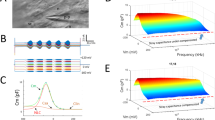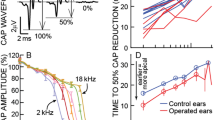Abstract
THE position of an auditory hair cell along the length of the cochlea determines the sound frequency to which it is most sensitive. Receptors located near the proximal end (base) of the cochlea are maximally stimulated by high-frequency sounds; those occupying successively more distal (apical) positions respond best to progress-ively lower frequencies1. At present, it is unclear how this frequency place map emerges with respect to the development of the cochlea. It has been suggested, on the basis of acoustic trauma experiments with developing chicks2 and cochlear potential recordings3–5 from developing gerbils, that this map may arise through systematic changes in the spatial encoding of frequency along the cochlea. Others have inferred from frequency tuning curves derived from auditory-nerve recordings in developing mammals6 and chicks7, that the cochlear frequency-place map remains stable throughout development. We analysed frequency tuning curves obtained from gerbil spiral ganglion cells at a constant location within the basal cochlea, and report here that these cells undergo significant increases (up to 1.5 octaves) in their best-response frequencies between the second and third weeks of postnatal life. These recordings provide direct evidence for developmental changes in the tonotopic organization of the mammalian cochlea.
This is a preview of subscription content, access via your institution
Access options
Subscribe to this journal
Receive 51 print issues and online access
$199.00 per year
only $3.90 per issue
Buy this article
- Purchase on Springer Link
- Instant access to full article PDF
Prices may be subject to local taxes which are calculated during checkout
Similar content being viewed by others
References
Von Bekesy, G. & Rosenblith, W. in Handbook of Experimental Psychology (ed. Stevens, J. S.) 1075–1115 (Wiley, New York, 1951).
Rubel, E. W. & Ryals, B. M. Science, 219, 512–514 (1983).
Harris, D. M. & Dallos, P. Science, 225, 741–743 (1984).
Yancey, C. & Dallos, P., Hearing Res. 18, 189–195 (1985).
Arjmand, E., Harris, D. & Dallos, P. Hearing Res. 32, 93–96 (1988).
Romand, R. Neurosci. Lett. 35, 271–276 (1983).
Manley, G. A., Brix, J. & Kaiser, A. Science, 237, 655–656 (1987).
Woolf, N. & Ryan, A. Hearing Res. 13, 277–283 (1984).
Woolf, N. & Ryan, A. Devl Brain Res. 17, 131–147 (1985).
Sanes, D. H. & Rubel, E. W. J. comp. Neurol. 279, 436–444 (1989).
Ryan, A. F. & Woolf, N. K. Devl Brain Res. 41, 61–70 (1988).
Woolf, N. K. & Ryan, A. F. Hearing Res. 35, 131–142 (1988).
Schmiedt, R. A. & Zwislocki, J. J. J. acoust. Soc. Am. 61, 133–149 (1977).
Romand, R. Hearing Res. 28, 117–123 (1987).
Dallos, P. & Cheatham, M. A. J. acoust. Soc. Am. 60, 510–512 (1976).
Liberman, M. C. Science, 216, 1239–1241 (1982).
Dolan, D. F., Teas, D. C. & Walton, J. P. J. acoust. Soc. Am. 78, 544–554 (1985).
Chamberlain, S. C. J. comp. Neurol. 171, 193–204 (1977).
Adams, J. J. Histochem. Cytochem. 29, 775 (1981).
Author information
Authors and Affiliations
Rights and permissions
About this article
Cite this article
Echteler, S., Arjmand, E. & Dallos, P. Developmental alterations in the frequency map of the mammalian cochlea. Nature 341, 147–149 (1989). https://doi.org/10.1038/341147a0
Received:
Accepted:
Issue Date:
DOI: https://doi.org/10.1038/341147a0
This article is cited by
-
Postnatal structural development of mammalian Basilar Membrane provides anatomical basis for the maturation of tonotopic maps and frequency tuning
Scientific Reports (2021)
-
Acid-sensing ion channels (ASICs) influence excitability of stellate neurons in the mouse cochlear nucleus
Journal of Comparative Physiology A (2019)
-
Development of auditory sensitivity in the barn owl
Journal of Comparative Physiology A (2017)
-
Developmental Changes of Mechanics Measured in the Gerbil Cochlea
Journal of the Association for Research in Otolaryngology (2008)
Comments
By submitting a comment you agree to abide by our Terms and Community Guidelines. If you find something abusive or that does not comply with our terms or guidelines please flag it as inappropriate.



